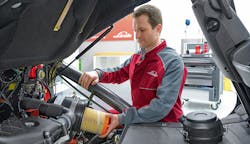Risk is a common factor in the workplace. From operating heavy machinery and handling volatile goods to catching up on paperwork, hazards are everywhere and aren’t always easy to find or anticipate. Accidents at work not only affect those involved, perhaps limiting their ability to work effectively or earn a living, but they have a dramatic effect on employers who often face penalties and other expenses in order to prevent future incidents.
Dangers in the warehouse can range from small slips, trips and falls to full-on collisions while handling machinery, often owing to poor maintenance or disrepair. The handling of pallets, the treatment of surfaces and the state of lighting can all have a profound impact on worker safety, and are also frequently taken for granted.
Machinery Maintenance and Repair
One of the most common incidents recorded in warehouses nationwide involves the use of forklifts and other warehouse machinery. These machines are integral to the efficient running of the warehouses in which they are employed, so any damage caused by accidents can have extremely negative consequences for any business. Most accidents stem from machines being improperly maintained and malfunctioning during use; even the most skilled operator can’t avoid an accident or collision if the machine is damaged and falls out of their control.
Regular maintenance and routine inspections are legal requirements for heavy machinery, but they can also save your organization a lot of time and resources in the long term. Any signs of wear and tear on machinery, such as warping of the forks on a forklift or damage to the tires, should be reported and looked at by a professional. While it may be tempting to use a ‘quick fix’ DIY solution, this can cause further damage to the machinery and result in more damage and higher costs in the long term.
Investing in PE and PP Pallets
Plastic pallets are becoming increasingly common in warehouse environments due to their rigidity and shock absorption qualities. Such pallets are manufactured from either polyethylene (PE) or polypropylene (PP), depending on their application. The former offers shock absorption capabilities while the latter is able to withstand high temperatures and friction more easily.
Due to these distinctive properties, plastic pallets are often seen as a safer option than traditional wood pallets and they’re designed to last a great deal longer—a worthwhile investment for any warehouse concerned with worker safety and efficiency.
Enhanced Visibility for Better Worker Safety
Warehouses are busy, crowded places where visibility can be rather restricted. This problem is made worse by poor lighting and accidents are far more likely to occur. Lighting in your warehouse is important at key locations, such as loading docks or busy junctions, but making sure the warehouse is adequately lit throughout will go a long way to reducing the number of accidents relating to visibility levels.
A common tactic is to use mirrors to let workers see around corners and busy junctions, while at the same time making the warehouse lighter and brighter.
Reducing Accidents through Risk Assessment
Risk is an everyday part of working in a warehouse, but an effective risk management system can go a long way to ensuring worker safety. Some risks are unavoidable, but by having a better understanding of them you can give your staff the knowledge and foresight to avoid accidents, drastically reducing the number of incidents and the resultant cost to business.
Not only is risk assessment a matter of best practice, it’s also a legal requirement, and failing to carry out proper assessment can lead to severe penalties as well as staff accidents. Whichever way you look at it, not carrying out a risk assessment is a drain on resources.
Manage Speed to Prevent Accidents
Operating warehouse machinery such as forklift trucks requires a great deal of care and responsibility. This applies more to a warehouse environment than anywhere else, with its enclosed spaces, tight turns and staff regularly passing through on foot. By enforcing speed limits with the use of signs and in-house procedures, a business can drastically reduce the risk of injury and collision. Machinery can even be fitted with speed-limiting devices to ensure that they are operated safely.
Make Surfaces Non-slip to Prevent Falls
Slips are one of the most common workplace accidents and in the confines of a warehouse, combined with poor lighting and the potential for leaking substances, they can be a real problem. One of the ways you can help prevent slips is to paint an anti-slip coating on the floor of your warehouse, which will improve traction for both vehicles and those working on foot.
Painting your floor with anti-slip paint also has the added benefit of protecting the floor against scratches and scuffs, and can reduce overall wear and tear that can result in uneven surfaces.
Managing Warehouse Spills Effectively
Accidents can occur at any time, and they won’t always be avoidable. For instances of leaks and spills, it’s less about prevention and more about response and how your staff are trained to deal with a given situation.
Consider placing ‘clean-up kits’ at strategic locations throughout the warehouse where spills are likely to occur to give staff the tools they need to deal with a spill if one should occur. For volatile or dangerous substances, it’s important to have relevant and appropriate safety apparatus available should they leak, in order to limit contamination.
Making sure that a warehouse is safe isn’t easy. It requires a thorough, robust approach, great attention to detail, investment in resources and quality training, but by making yourself aware of the most common dangers, such as those outlined above, you can help ensure your warehouse is as safe a working environment as possible.
Mark Sulllivan is head of customer service with Linde Aftersales, a company that specializes in the maintenance and repair of forklift machinery.
